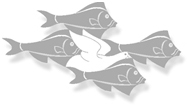

|
|
|
|
L. Saroul
Ph.D. dissertation by Laurent Saroul, under the supervision of Prof. Roger D. Hersch, Thesis No 3575 presented at the School of Computer & Communication Sciences, Ecole Polytechnique Fédérale de Lausanne, July 2006
In the last years, three-dimensional (3D) medical imaging techniques have taken an increasing importance in patient care and medical research. Volume images provide medical specialists with a direct access to the interior of a patient’s body and reduce the need for invasive exploration. The use of volume imaging modalities such as X-ray CT, PET or MRI has therefore become essential for medical diagnosis and surgical planning.
Computer visualization techniques such as extraction of planar slices of arbitrary orientation (Multiplanar Reprojection), surface rendering of anatomic structures, and volume rendering provide medical users with the tools for exploiting 3D volume images.
Surface or respectively volume rendering provides information about the 3D geometry and 3D context of the structures of interest but does not allow to directly visualize original intensities, respectively colors located within the 3D structures. In addition, surface rendering requires the segmentation of the volume data and volume rendering often requires a classification of the volume image pixels. In contrast, the extraction of planar sections provides interactivity, requires no pre-processing and the original intensity, respectively color of each slice element may be directly inspected. However, it does not allow the visualization of curved anatomic structures within a single slice. In this thesis, we propose to overcome this limitation by generalizing the concept of planar section to the extraction of curved cross sections.
In the first part, we focus on the interactive extraction of curved surfaces from volume images. Unlike planar slices, curved cross-sections may follow the trajectory of tubular structures such as the Aorta or follow structures with an irregular shape such as the Pelvis. In the second part of this work, we focus on the visualization of curved surfaces. We would like to offer the possibility of carrying out distance measurements along a structure of interest both for medical applications and for anatomical studies. Orthogonal or perspective projection of curved surfaces induces angular and metric distortions as well as surface overlapping. In order to enable measurements, we propose to use surface flattening methods, which preserve distances along specific orientations and minimize distortions around a focus point. Flattening of curved cross-sections enables inspecting spatially complex relationship between anatomic structures and their neighbourhood. They also allow the visualization of a curved anatomic structure within a single planar view and therefore to precisely inspect the original intensity, respectively color at each surface point. Thanks to a multi-resolution approach, surfaces are flattened at interactive rates, allowing users to displace the focus point during the visualization of the flattened surface. We also propose a new efficient method for computing a flattened surface minimizing global distortions and still preserving distances along one orientation.
Surface extraction and flattening techniques are integrated into an interactive visualization Java applet. This Java applet enables anyone to precisely and interactively inspect the Visible Human anatomy. Besides medical visualization, the presented methods may also be useful for creating new interesting views of anatomic structures for didactic purposes.
Download the full paper: PDF 8 MB
![]()
![]()
![]()
![]()
![]()